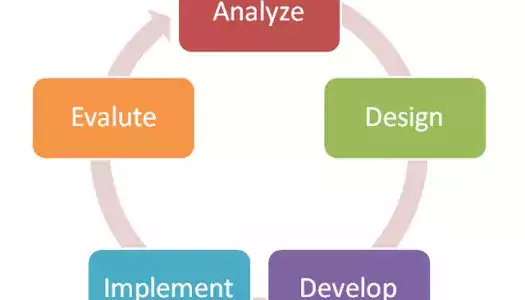It doesn’t take long for anyone working in professional development to hear about ADDIE and SAM. Who are these uppercase people? You quickly learn they’re not people but acronyms for instructional design models. And when you hear SAM stands for Successive Approximation Model, you understand why the acronym is preferred.
In this Learning Science Made Easy series, we’re covering the basics of instructional design models so you can keep up when the conversation gets geeky. Besides ADDIE, we’ve covered:
- Gagne’s 9 Events of Instruction
- Bloom’s Taxonomy
- Merrill’s Principles of Instruction
- Retrieval Practice
Instructional designers use SAM or ADDIE to guide the course creation process, and the other models on our list to design the learning experience.
ADDIE and SAM: frenemies or what?
ADDIE stands for five phases of the course creation process: Analyze, Design, Develop, Implement, and Evaluate. It’s a traditional waterfall method of project management with roots in the military. In a waterfall project, you complete one phase before moving to the next, always marching forward.
Typically, ADDIE projects have long timelines, although instructional designers with a fondness for ADDIE have adapted it to make it more agile. Still, you’ll often see ADDIE described as slow and steady, whereas SAM is known as fast and furious.
Where there’s a need for speed, call on SAM. It’s a rapid design and development model that’s essential for getting products to market more quickly. The brainchild of Dr. Michael Allen, founder and CEO of Allen Interactions, SAM is ‘successive’ because progress is made in small, quick steps. The model refers to ‘approximation’ because the prototype developed for feedback is an approximation of the final result.

SAM was designed from the start for agile instructional design. Agile is the counterpart to waterfall in the project management world. The agile concept was popularized by software developers who completed their work in cycles (called ‘sprints’). With SAM, you test different solutions for one function or element, get feedback, make modifications, and then test again. There’s a lot going on simultaneously with a SAM project. You’re working on more than one thing at a time.
Because you test elements of the course early and often, and refine them based on user feedback, a SAM project takes weeks, not months, like ADDIE. With ADDIE, you’re not getting feedback until testing at the end of the Develop phase.
SAM can feel a little scary the first time with its tight timelines and quick turnarounds. The focus is on failing fast and forward, not perfection, but this method allows for more innovation. It’s a collaborative model with lots of involvement by SMEs and stakeholders throughout the process since you need their feedback when testing iterations.
The three phases of instructional design with SAM
SAM has three phases: preparation, iterative design, and iterative development. The emphasis is on ‘iterative’ because you repeat a process or steps and modify or refine as you get closer to a goal.
#1: Preparation
The Preparation stage lasts one day to one week. Project goals are determined. You gather information about learners through audience research, surveys, and LMS metrics. You identify the skills and knowledge needed, existing skills and knowledge, and learning styles. SMEs start thinking about key takeaways and activities.
The centerpiece of the Preparation stage is the Savvy Start. Project managers, SMEs, instructional or learning experience designers, and other stakeholders have a brainstorming session to come up with ideas for the design and delivery of the course.
The end results are unpolished prototypes or storyboards of potential designs for each module of the course. That’s ‘designs’ plural, not just one potential design. The prototypes don’t include interactive elements yet, just sketches of how different solutions might look. These prototypes are the basis for future design sessions.
#2: Iterative design
A smaller group of SMEs and instructional designers then get into project planning: timeline, budget, clarification of roles and responsibilities, and assignment of tasks.
The instructional designers design and refine (in iterations) elements of the prototypes or storyboards. They’re not focused on a single solution yet. Trying out alternatives (experts recommend three) to see what works best forces the team to be creative and think beyond the obvious.
The goal of this phase is to get feedback (and buy-in) from SMEs and stakeholders on different solutions and elements of the final product so you can settle on a final design proof. At this stage, the design proof is fully functional. It includes all the components needed in the finished product, for example, media and interactive exercises.

#3: Iterative development
Now that you have a final design, you enter a cycle of developing, implementing, evaluating, modifying, and repeat—a constant feedback loop. However, unlike ADDIE, you’re not going through this cycle with the entire course at once. Just like in previous phases, you’re doing it in pieces, so while instructional designers modify module 4, SMEs might evaluate module 1 and reevaluate module 6.
The product at this stage has three iterations.
- Alpha version: A team of SMEs, stakeholders, and/or users tests the first complete and fully functional version of the product. You shouldn’t encounter any major flaws because every element of the course has already been evaluated and modified but might need minor editing.
- Beta version: You do this final review after correcting minor errors discovered during the testing of the Alpha version.
- Gold version: The final product is ready to launch.
Benefits of SAM
Budget/schedule. You’re unlikely to go over budget or schedule because of last-minute revisions. With constant feedback and testing throughout the process, it’s easier to understand what the final product should look like. You catch errors early and have time to make adjustments or massive overhauls as you go.
Buy-in. Because stakeholders are providing feedback on early prototypes, you get their buy-in early.
Scope changes. Flexibility and feedback are built into SAM. If requirements change, you can pivot and rework components. You don’t have to go back to an earlier phase and start everything completely from scratch.
Innovation. Since failing is expected as part of the SAM process, your team can take risks on innovative design elements and test them early to see if they might work.
If responsiveness to market needs is a challenge, talk to your instructional designers about SAM. With SAM in the picture, it makes you wonder if there is still a place for ADDIE in a fast-moving world where associations need to get to market quickly in response to changing member and customer needs.






